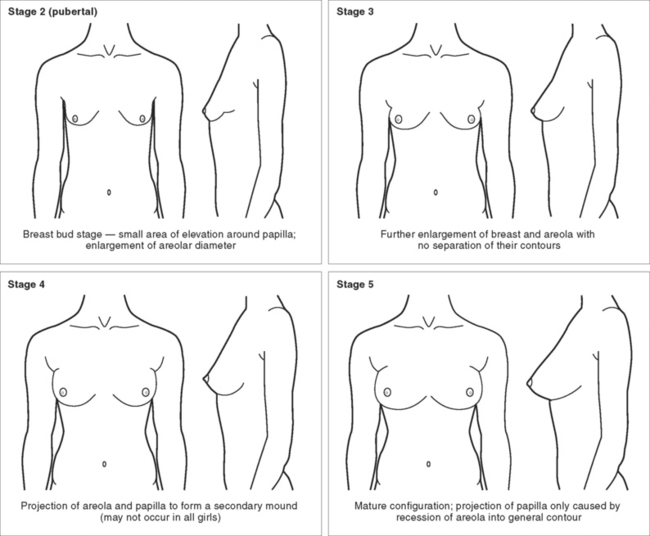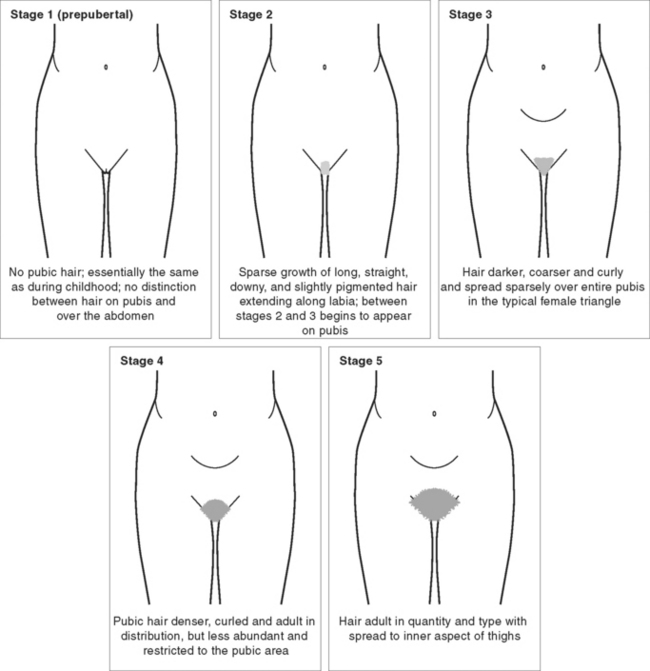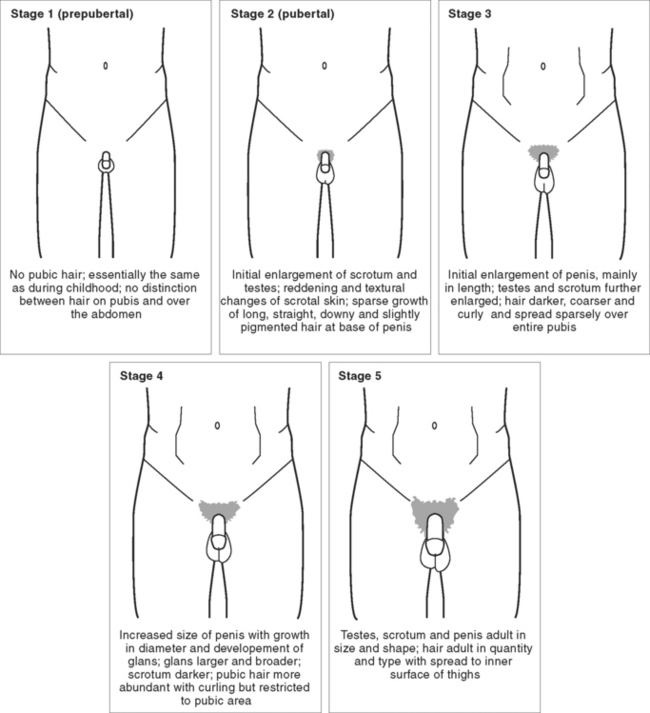Chapter 16 GROWTH AND DEVELOPMENT: LATE CHILDHOOD THROUGH TO ADOLESCENCE
An understanding of adolescent development is essential for nurses in their daily practice. Adolescence is the period in the lifespan where the individual, previously reliant on parents and carers for values and identity, becomes independent and, in this move towards independence, attempts to create a new and personal identity. It is a time when group identity is vital, often a time of experimentation with self-image, and a time to question family values and beliefs. Adolescents are capable of abstract thought and understand many variables within a given situation. This chapter highlights the growth and development of the adolescent and how nursing knowledge of this phase can provide optimal nursing care for the adolescent when hospitalised.
PREADOLESCENCE
PHYSICAL DEVELOPMENT
Preadolescence physically refers to the beginning of the second skeletal growth spurt, when physical changes such as the development of female breasts and pubic hair also begins. These physical changes occur about 2 years earlier in girls than boys (Graber et al 1997).
In the preadolescent stage children become more social and their behavioural patterns become much less predictable. Included in this stage is experimentation with make-up by girls and an interest in music and performers that are popular with older adolescents. Interest in sexual activity develops. Preadolescents often develop friendships with adults other than their parents. They use these relationships to gather information about adults. (See Chapter 12 for more information on sexuality and the adolescent.)
ADOLESCENCE
The term adolescent usually refers to psychological maturation of the person, whereas puberty refers to the point at which sexual maturity is achieved and reproduction becomes possible. Puberty mainly refers to the maturational, hormonal and growth process that occurs when the reproductive organs begin to function and the secondary sex characteristics develop. Adolescence is the period of transition between puberty and adulthood (Mitchell & Ziegler 2007).
PHYSICAL DEVELOPMENT
The main physical changes are:
Growth in height usually stops at age 18–20 in boys. The individual often appears awkward and clumsy and the sequence of changes is responsible for the long-legged gawky appearance that is often seen. These changes require the adolescent to adjust their perception of their self in space as well as accepting a new body image. Fat becomes redistributed into adult proportions as height and mass increase, and the adolescent gradually assumes an adult appearance. Adolescents are concerned about physical changes that make them different from their peers, and the nurse should reassure them about normal growth curves and that their own growth patterns are normal (Green-Hernandez et al 2001).
HORMONAL CHANGES OF PUBERTY
The increase in hormonal activity during puberty leads to maturing of the body shape and achievement of fertility. All physical changes are the result of hormonal influences. Hormonal production is controlled by the anterior pituitary gland, which is in turn stimulated by the hypothalamus. The stimulation of the anterior pituitary results in the release of the gonadotrophic hormones that stimulate the gonads. As a result of this stimulation, testicular cells produce testosterone and ovarian cells produce oestrogen. These hormones contribute to the development of secondary sex characteristics and play an essential role in reproduction. The changing concentration of these hormones is also linked to problems of adolescence, such as body odour and acne (Green-Hernandez et al 2001; Clinical Interest Box 16.1).
Sexual maturation in girls
The initial indication of puberty in most girls is the appearance of breast buds. Breasts begin to develop from about age 10 (development continues until about age 17) (Figure 16.1). Around 2–6 months later, growth of pubic hair on the mons pubis begins (Figure 16.2). The initial appearance of menstruation (menarche) occurs about 2 years after the first pubescent changes. The normal age range of menarche is 10.5–15 years, with ovulation usually beginning 6–14 months after menarche.

Figure 16.1 Development of breasts in girls. Stage 1 (prepubertal elevation of papillae only) not shown
(Adapted from Hockenberry 2005 [Modified from Marshall WA, Tanner JM: Arch Dis Child 44:291, 1969; Daniel WA, Paulshock BZ: A Physician’s guide to sexual maturity, Patient Care May 13, 122–124, 1979])

Figure 16.2 Growth of pubic hair in girls
(Adapted from Hockenberry 2005 [Modified from Marshall WA, Tanner JM: Arch Dis Child 44:291, 1969; Daniel WA, Paulshock BZ: A Physician’s guide to sexual maturity, Patient Care May 13, 122–124, 1979])
Concerns about pubertal delay in girls should be considered if breasts have not started to develop by age 13 or if menarche has not occurred within 4 years of the onset of breast development (Sigelman 2003).
Sexual maturation in boys
Testicular enlargement accompanied by thinning, reddening and increased looseness of the scrotum are the first pubescent changes in boys and usually occur between age 9.5 and 14. This is often followed by the initial appearance of pubic hair. Penile enlargement begins, with continuing testicular enlargement and growth of pubic hair (Figure 16.3). Facial hair may develop along with early voice changes. Gynocomastia, temporary breast enlargement, and tenderness are common during mid-puberty. This breast enlargement usually disappears within 2 years. Height and weight growth occur towards the end of mid-puberty. Nocturnal emissions of seminal fluid are an indication of puberty in the male and occur spontaneously and periodically during sleep. In late puberty the testicles and penis enlarge, and the voice deepens. Axillary hair develops and facial hair extends to cover the neck.

Figure 16.3 Developmental stages of secondary sex characteristics and genital development in boys
(Adapted from Hockenberry 2005 [Modified from Marshall WA, Tanner JM: Arch Dis Child 44:291, 1969; Daniel WA, Paulshock BZ: A Physician’s guide to sexual maturity, Patient Care May 13, 122–124, 1979])
The physical changes that occur during adolescence are rapid and dramatic and play a significant role in psychosocial development. By understanding these hormonal changes the nurse is able to reassure and educate adolescents about their body care needs. The timing of these physical changes depends on factors such as heredity and nutrition and whether the child is a boy or girl. The sequence of pubertal growth changes (Tables 16.1 & 16.2) are the same in most individuals (Sigelman 2003).
TABLE 16.1 Usual sequence of maturational changes in adolescence
| Boys | Girls |
|---|---|
TABLE 16.2 Growth and development during adolescence
| Early Adolescence (11–14 years) | Middle Adolescence (14–17 years) | Late Adolescence (17–20 years) |
|---|---|---|
| Growth | ||
| Cognition | ||
| Identity | ||
Stay updated, free articles. Join our Telegram channel
Full access? Get Clinical Tree
 Get Clinical Tree app for offline access
Get Clinical Tree app for offline access
Get Clinical Tree app for offline access

| ||